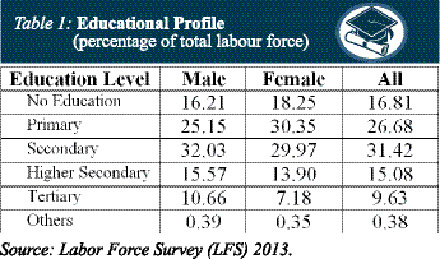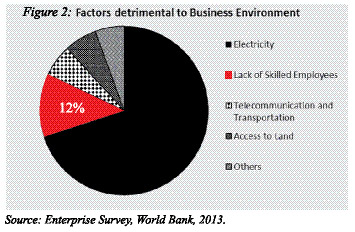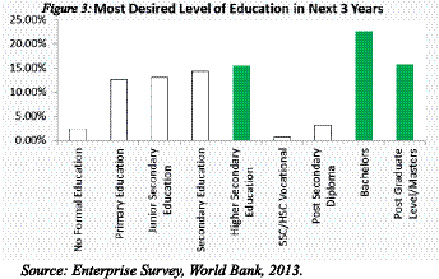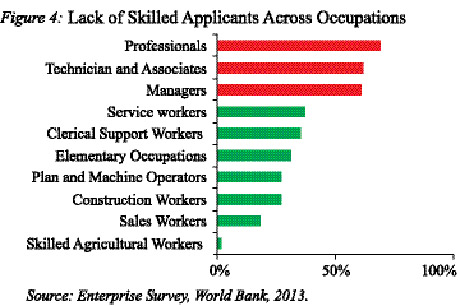Sayema Haque Bidisha and Deen Taposh | November 15, 2017 00:00:00
For attaining sustainable and high growth rate of an economy and improving the living standard of its people, the role of skill development cannot be over- emphasised. Skill development not only enhances and expands an individual's capacity of earning, the formation has the potential of transforming the nation's workforce into a more productive one and thereby contributing immensely towards the growth momentum of an economy.
It, however, is not a short-term or temporary phenomenon, but should be treated as a cumulative process which begins at early stages of life and can continue over the entire lifespan through a number of avenues (WB, 2014).
Given its importance, the Government of Bangladesh (GoB) has prioritized the strategy of skill development as one of the prerequisites for achieving the middle-income status by 2030.
Bangladesh, despite of attaining consistently high growth rates of above 6% over the last five years and making remarkable progress in a number of human development indicators, is still a long way off in possessing a skilled workforce. On the one hand, a very small percentage of its population possesses tertiary level of education or high skill level and on the other, mismatch between the demand and supply of relevant skills is often argued as a key reason behind unemployment and inefficiencies on the labour market. As a result, despite having an abundance of manpower and a varied skill level in the workforce, the labour market of the country is argued to be characterized by persistent unemployment/under-employment, with majority of its workforce concentrated in low-productive and low-paid jobs. The policy focus, therefore, should not only be on generating job opportunities but also on providing opportunities for the workers to get decent jobs with stable earnings through formal institutional arrangements. In realising such goal, skill development through education and training can play an important part.
Given the current education structure, one avenue of skill development can be through technical and vocational education (TVE) which can be considered mid-range skill-developing platforms that which can help in providing employment opportunities for the large pool of unemployed and under-employed masses and fulfilling the demand for the skill levels required for the transition towards greater degree of industrialization. In the context of TVE, for pursuing effective skill formation strategies, there remain a number of challenges including those of lesser market orientation of skills-training programmes, back-dated curriculum, inequities in terms of targeting those in the remote areas, etc.
Skills acquired through formal educational institutions, e.g., primary, secondary and tertiary levels, on the other hand, are at the higher spectrum of skill development. Such skill development can serve the requirement of high-skilled works, like those of health professionals, engineers, science and technology specialists etc., and are imperative to meet the United Nations Sustainable Development Goals (SDGs) and thereby to lift the country towards the higher growth trajectory in the medium-to long run. With a view to generating employment for the large mass of people and to attain the SDG goals within the stipulated time, policy focus should, therefore, be attached to both streams of skill-development programs.


Analyzing the skill profile of current labour supply: Since labour force is argued to be one of the major engines of economic growth, it is crucial to understand its quality in terms of skill composition. In this regard, it is the productivity of labour which is of prime interest and the role of education, either vocational or tertiary, can therefore be of paramount importance in this regard.
Despite a gradual improvement over time, data from 2013 labour force survey show that still a very small percentage of labour force possesses tertiary-level education. Also only around 17% of labour force (16% males and 18% females) are found to have possessed no education (Table 1). The quality of labour force at present is therefore not that attractive in terms of educational qualifications.
In the face of increased competitiveness on the global market, the role of Information and Communication Technology (ICT) services in raising productivity of workers has increasingly become important. However, only 15% of labour force has reported to have used internet and 11% has reported to have used computer (LFS, 2013). Therefore, despite the recent expansion of ICT services, the coverage is yet to contribute to human resource development for the greater mass, especially for the youth sub-segment.
The attainment data are not significantly different in TVE as well. Only around 10% of labour force has reported to have received some sort of training where this percentage is even lower for females. According to the LFS 2013,27.67% received training in computer-related studies, 24.53% in agriculture crop production and preservation, and 9.75% respondents received training in the field of readymade garments. According to survey data, high skill training was not widely available. Majority of the respondents who received any form of training reported that they received it from private institutes as government TVE institutions are generally located near urban centres and most of the time unreachable for rural females in particular. Figure 1depicts the duration of training received and it is evident from the data of LFS 2013 that most of the training that the respondents completed is short-term in nature, ranging from one to four weeks. Since short-term training is, generally, associated with low-skilled jobs and generates limited earning opportunities, there is a need for promoting the necessity of medium (one to six months) and longer-term (6 months+) training courses, concentrated on high skill formation.



Understanding the Demand for Skill: In Bangladesh, though there is a lack of detailed quantitative information on labour demand, the World Bank`s 2013 Enterprise Survey reveal a number of interesting facts:
l According to the sample employers, lack of skilled employees ranks second on the list of factors detrimental to the business environment of Bangladesh (12%), which has just been cited next after the problem of electricity (Figure 2).
l From the employers' perspective, the most desired levels of education in the next three years are, Bachelors, Post-graduate/Masters and Higher Secondary Education, reflecting the urgency of investing in tertiary education (Figure 3).
l Figure 4 shows employers' perception on lack of skill level at different stages. The figure reveals that there is a serious lack of skilled applicants in higher-skilled occupations, such as, in Mangers, Technicians and Associate Professionals and Professionals categories.
l Figure 5 shows the importance of soft skills, e.g., communication and teamwork skills, in Bangladeshi labour market. Since skill formation proceeds in stages, soft skills are, generally, associated with higher levels of education. The problem-solving skills are, also, a matter of great concern.
The issue of skill mismatch: It is widely accepted that labour-market outcomes are often imperfect and are unable to produce perfect demand-supply equilibrium, which results in a noticeable imbalance between acquired skill levels and existing occupation categories. Based on a skill-mismatch index across 64 districts of Bangladesh (Bidisha et al., 2016), a significant degree of skill mismatch around the country was found. The situation is found to be worst in the districts of Tangail, Sylhet, Sirajganj, Rangpur, Rajshahi, Pirojpur, Patuakhali, Pabna, Noakhali, Nilphamari, Narsingdi, Narayanganj, Narail, Munshiganj, Meherpur, Moulvibazar, Magura, Lakshmipur, Kishoreganj, Khulna, Jessore, Habiganj, Gazipur, Feni, Faridpur, Dhaka, Chittagong, Chandpur, Brahmanbaria, and Barisal. These findings reveal few things: Firstly, there is a significant level of skill-mismatch in all the major economic zones of the country. Secondly, higher skill-mismatch indices in major economic zones restate the unequal economic opportunities among different regions. Finally, in the context of Bangladesh, the degree of unemployment can be structural, rather than cyclical, in nature.
Challenges for skill formation & key recommendations: Though the importance of skill formation of the labour force has repeatedly been pointed out in a number of national policy documents, such as the 7th Five-Year Plan (FYP), the National Skills Development Policy 2011, and the Education Policy 2010, the challenge, however, seems to be in the implementation of these policies. Inefficiencies in the delivery mechanism of these nationwide policies, such as bureaucratic complexities, and incoherence between different educational entities providing skill-formation services are often seen as major obstacles to realising the intended outcome.
In addition to these core supply-side challenges, infrastructural bottlenecks and low-level of private investment are also widening the gap between skills supplied and skills demanded on the labour market. Gaps are also apparent in the types of skill demanded in comparison to the existing skill component of the workforce-leading to waste of skill and low level of production techniques that are hindering the growth process of the country.

That is to say, the key challenges of skill formation, specifically in relation to the stated national plans and United Nations Sustainable Development Goals(SDGs), can primarily be fivefold: (i) skill mismatch in domestic as well as in overseas market, in terms of both long-term development plans and short-term industrial needs; (ii) insufficient coverage and gender -- and region- specific inequities in skill formation, particularly in the context of TVE and tertiary education; (iii) high repetition and dropouts, along with low rates of transition across different education stages (at primary, secondary, tertiary and TVE); (iv) (arguably) 'poor' quality of educational inputs (including curriculum, teaching materials/machinery, teaching stuffs and equipment) and ineffective examination system at different education stages (at primary, secondary, tertiary and TVE); and (v) discrepancies across educational institutes in terms of quality of education. Against this backdrop, with a view to attaining the aspired middle-income status by 2030 with social inclusion of its population, a number of key recommendations in terms of skill formation of the labour force can be proposed:
l In order to achieve 8% growth as proposed in the 7thFYP, the most crucial policy step would be to increase allocation in human resource development, such as in education, particularly in TVE, by a much greater margin.
l In combating skill mismatch, one of the most crucial solutions could be to align the existing curriculum with current market demand and future market trend. In this context, policies, such as, strengthening the collaboration between vocational institutes and industry (as practiced in Thailand and China); involving industry-sector representatives in designing curriculum (as practiced in India); and linking secondary education with the TVE programmes, through an effective collaboration between the Ministry of Labour and the Ministry of Commerce (as practiced in India),would be useful.
l The 'quality' of education, particularly at primary and secondary levels, should be emphasized, so that skill acquisition becomes easier at later stages ofTVE or/and at the tertiary level.
l A proper coordination and consistency across the modes of teaching, curricula, and textbooks across different streams of education, such as public, private, NGO-run school, and madrassa, is essential.
l Given the constraint of household responsibilities of women/young mother in labour market participation, an important policy intervention could be to establish daycare centers at the workplaces/educational institutions. However, a holistic approach is needed like that of preventing child marriage and early pregnancy for girls in the long run to improve the low participation of women/young mother.
l Bangladesh requires raising its tertiary enrolment rate from the current 10% to as high as 24% in order to maximize its economic growth (Bidisha et al., 2016). Improvement in tertiary enrolment may require an extensive policy focus on budgetary allocation. In addition, policies need to be aligned to modernize tertiary education and emphasis should be given on matching the demand side`s expectation of producing more graduates in the field of science and engineering.

A worker in an RMG factory in Bangladesh — FE Photo
l Due to disproportionately distributed economic opportunities across different regions of the country, there is a felt need for decentralized labour-market policies to create balanced economic opportunities across the country. It could be worthwhile to design specific policies for major economic zones, keeping their specific skill needs in mind, rather than creating a nation-wide strategy.
Dr Sayema Haque Bidisha is Associate Professor, Department of Economics, the University of Dhaka. sayemabidisha@gmail.com
Deen Taposh is Evaluation Officer, National Research Council, Canada.
deen.taposh@gmail.com
© 2025 - All Rights with The Financial Express
